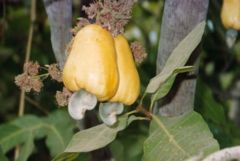Anacardium
| Anacardium subsp. var. | ||||||||||||||||||||||||||||||||||||||||||||||||||||||||
|---|---|---|---|---|---|---|---|---|---|---|---|---|---|---|---|---|---|---|---|---|---|---|---|---|---|---|---|---|---|---|---|---|---|---|---|---|---|---|---|---|---|---|---|---|---|---|---|---|---|---|---|---|---|---|---|---|

|
|
| ||||||||||||||||||||||||||||||||||||||||||||||||||||||
| ||||||||||||||||||||||||||||||||||||||||||||||||||||||||
Anacardium is a genus of flowering plants in the family Anacardiaceae, native to tropical regions of the Americas.
| Standard Cyclopedia of Horticulture |
|---|
|
Anacardium (name refers to the heart-shaped character of the nut). Anacardiàceae. Eight species native to the American tropics, of which one (yielding the cashew nut) is widely cultivated in tropical countries. Trees and shrubs with leathery alternate lvs.: fls. small and numerous in panicles, polygamous; calyx 5-cleft; petals 5, very narrow; stamens 7-10: fr. kidney-shaped, borne on a greatly enlarged hard receptacle.
|
Cultivation
Propagation
Pests and diseases
Species
- Selected species
- Anacardium corymbosum
- Anacardium excelsum
- Anacardium giganteum
- Anacardium humile
- Anacardium microcarpum
- Anacardium nanum
- Anacardium negrense
- Anacardium occidentale - Cashew
- Anacardium spruceanum
Gallery
-
photo 1
-
photo 2
-
photo 3
References
- Standard Cyclopedia of Horticulture, by L. H. Bailey, MacMillan Co., 1963
External links
- w:Anacardium. Some of the material on this page may be from Wikipedia, under the Creative Commons license.
- Anacardium QR Code (Size 50, 100, 200, 500)
